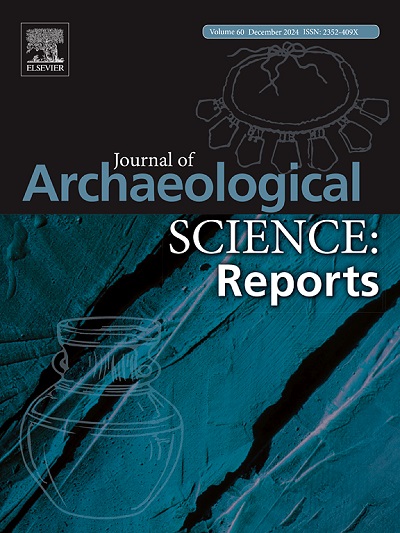逐层分析--通过地球化学、土壤学和统计学方法解构亚姆纳亚库尔干(罗马尼亚瓦拉钱平原)
IF 1.5
2区 历史学
0 ARCHAEOLOGY
引用次数: 0
摘要
库尔干是欧亚大陆一望无际的大草原上奇特的人造地貌。这些墓冢不仅是具有显著植物学、动物学、教育学和地貌学价值的古迹,而且作为文化遗产的组成部分,它们还代表着景观中独特的美学和文化历史意义。此外,坟丘下的土壤是古代景观形成因素和土壤生成过程的信使。一个长约位于 Boldești-Grădiștea 村(罗马尼亚,普拉霍瓦县)附近的一座高约 3 米的库尔干土丘于 2019 年进行了发掘,并在横截面上展开了所有相关层和埋藏层的取样,以进行地球化学和土壤学调查。取样分辨率为 5 厘米。现场土壤宏观形态描述和基本土壤理化方法用于描述复原(文化)层和土壤层位。此外,还采用了 MP-AES 和 ICP-MS 方法来确定土层和土层的元素组成。通过主成分分析(PCA)和分层聚类分析探索了多元空间的模式。然后使用线性判别分析(LDA)来评估聚类成员的概率。最后,应用线性判别分析模型对土墩附近采集的背景样本进行分类。所检索到的信息不仅用于确定施工阶段,还用于区分库尔干在建造和后期扩建过程中的各种材料选择。本文章由计算机程序翻译,如有差异,请以英文原文为准。
Layer by layer – Dismantling a Yamnaya kurgan by geochemical, pedological and statistical approaches (Wallachain Plain, Romania)
Kurgans are peculiar, human-made formations of the endless steppes of Eurasia. These burial mounds are not only monuments of notable botanical, zoological, pedological and geomorphological values, but as elements of the cultural heritage they also represent unique aesthetical and cultural historical significance in the landscape. Moreover, the soils under the mounds are the messengers of ancient landscape forming factors and soil generation processes. A ca. 3 m high kurgan located near the village of Boldești-Grădiștea (Romania, Prahova County) was excavated in 2019 and the cross-section, unfolding all relevant layers and buried horizons, were sampled for geochemical and pedological investigation. The sampling resolution was 5 cm. On-site soil macro-morphological description and basic soil physical and chemical methods were applied to describe the recovered (cultural) layers and soil horizons. In addition, MP-AES and ICP-MS methods were used to identify the elemental composition of the layers and horizons. Via Principal Component Analysis (PCA) and hierarchical cluster analysis patterns of the multivariate space were explored. Linear discriminant analysis (LDA) was then used to assess the probability of cluster memberships. Finally, the LDA model was applied to categorize the background samples collected from the vicinity of the mound. The information retrieved was not only used to identify construction phases, but also to distinguish various material choices during the erection and the later enlargement of the kurgan.
求助全文
通过发布文献求助,成功后即可免费获取论文全文。
去求助
来源期刊

Journal of Archaeological Science-Reports
ARCHAEOLOGY-
CiteScore
3.10
自引率
12.50%
发文量
405
期刊介绍:
Journal of Archaeological Science: Reports is aimed at archaeologists and scientists engaged with the application of scientific techniques and methodologies to all areas of archaeology. The journal focuses on the results of the application of scientific methods to archaeological problems and debates. It will provide a forum for reviews and scientific debate of issues in scientific archaeology and their impact in the wider subject. Journal of Archaeological Science: Reports will publish papers of excellent archaeological science, with regional or wider interest. This will include case studies, reviews and short papers where an established scientific technique sheds light on archaeological questions and debates.
 求助内容:
求助内容: 应助结果提醒方式:
应助结果提醒方式:


